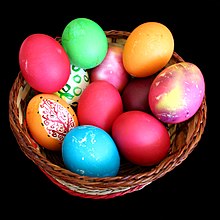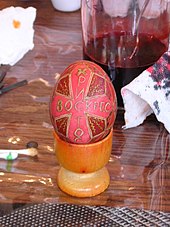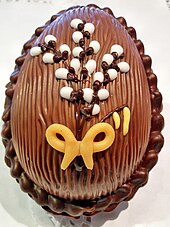
Back Paaseier Afrikaans بيض الفصح Arabic بيض الفصح ARZ Pasxa yumurtası Azerbaijani Margotē BAT-SMG Велікоднае яйка Byelorussian Велікодная пісанка BE-X-OLD Великденско яйце Bulgarian Hintalu Paskah BJN Ou de Pasqua Catalan



Easter eggs, also called Paschal eggs,[1] are eggs that are decorated for the Christian holiday of Easter, which celebrates the resurrection of Jesus. As such, Easter eggs are commonly used during the season of Eastertide (Easter season). The oldest tradition, which continues to be used in Central and Eastern Europe, is to dye and paint chicken eggs.
Although eggs, in general, were a traditional symbol of fertility and rebirth,[2] in Christianity, for the celebration of Eastertide, Easter eggs symbolize the empty tomb of Jesus, from which Jesus was resurrected.[3][4][5] In addition, one ancient tradition was the staining of Easter eggs with the colour red "in memory of the blood of Christ, shed as at that time of his crucifixion."[3][6]
This custom of the Easter egg, according to many sources, can be traced to early Christians of Mesopotamia, and from there it spread into Eastern Europe and Siberia through the Orthodox Churches, and later into Europe through the Catholic and Protestant Churches.[6][7][8][9] Additionally, the widespread usage of Easter eggs, according to mediaevalist scholars, is due to the prohibition of eggs during Lent after which, on Easter, they have been blessed for the occasion.[10][11]
A modern custom in some places is to substitute chocolate eggs wrapped in coloured foil, hand-carved wooden eggs, or plastic eggs filled with confectionery such as chocolate.

- ^ "The Legend of Paschal Eggs (Holy Cross Antiochian Orthodox Church)" (PDF). Archived (PDF) from the original on 2015-04-12. Retrieved 2013-11-26.
- ^ David Leeming (2005). The Oxford Companion to World Mythology. Oxford University Press. p. 111. Retrieved 10 March 2013.
For many, Easter is synonymous with fertility symbols such as the Easter Rabbit, Easter Eggs, and the Easter lily.
- ^ a b Anne Jordan (5 April 2000). Christianity. Nelson Thornes. ISBN 9780748753208. Archived from the original on 9 April 2023. Retrieved 7 April 2012.
Easter eggs are used as a Christian symbol to represent the empty tomb. The outside of the egg looks dead but inside there is new life, which is going to break out. The Easter egg is a reminder that Jesus will rise from His tomb and bring new life. Orthodox Christians dye boiled eggs red to make red Easter eggs that represent the blood of Christ shed for the sins of the world.
- ^ The Guardian, Volume 29. H. Harbaugh. 1878. Archived from the original on 9 April 2023. Retrieved 7 April 2012.
Just so, on that first Easter morning, Jesus came to life and walked out of the tomb, and left it, as it were, an empty shell. Just so, too, when the Christian dies, the body is left in the grave, an empty shell, but the soul takes wings and flies away to be with God. Thus you see that though an egg seems to be as dead as a stone, yet it really has life in it; and also it is like Christ's dead body, which was raised to life again. This is the reason we use eggs on Easter. (In days past some used to color the eggs red, so as to show the kind of death by which Christ died,-a bloody death.)
- ^ Gordon Geddes, Jane Griffiths (22 January 2002). Christian belief and practice. Heinemann. ISBN 9780435306915. Archived from the original on 9 April 2023. Retrieved 7 April 2012.
Red eggs are given to Orthodox Christians after the Easter Liturgy. They crack their eggs against each other's. The cracking of the eggs symbolizes a wish to break away from the bonds of sin and misery and enter the new life issuing from Christ's resurrection.
- ^ a b Henry Ellis (1877). Popular antiquities of Great Britain. p. 90. Retrieved 26 March 2016.
Hyde, in his Oriental Sports (1694), tells us one with eggs among the Christians of Mesopotamia on Easter Day and forty days afterwards, during which time their children buy themselves as many eggs as they can, stain them with a red colour in memory of the blood of Christ, shed as at that time of his crucifixion. Some tinge them with green and yellow.
- ^ Thompson, Kenneth (21 August 2013). Culture & Progress: Early Sociology of Culture, Volume 8. Routledge. p. 138. ISBN 9781136479403.
In Mesopotamia children secured during the 40-day period following Easter day as many eggs as possible and dyed them red, "in memory of the blood of Christ shed at that time of his Crucifixion"--a rationalization. Dyed eggs were sold in the market, green and yellow being favorite colors. The use of eggs at Easter seems to have come from Persia into the Greek Christian Churches of Mesopotamia, thence to Russia and Siberia through the medium of Orthodox Christianity. From the Greek Church the custom was adopted by either the Roman Catholics or the Protestants and then spread through Europe.
- ^ Cite error: The named reference
Historywas invoked but never defined (see the help page). - ^ Cite error: The named reference
Itihaaswas invoked but never defined (see the help page). - ^ Cite error: The named reference
Gainsford2018was invoked but never defined (see the help page). - ^ Cite error: The named reference
D'Costawas invoked but never defined (see the help page).
© MMXXIII Rich X Search. We shall prevail. All rights reserved. Rich X Search